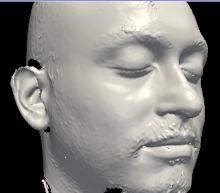Deformable models
Last week i came across a very interesting concept in computational vision. Segmentation used to be a very widely researched area in the past, and researchers have come up with some very intuitive ways of segmenting. One of such methods is the Deformable model which is used to segment regions of interest, however, with a-priori information. Deformable models are widely used in face dectection and medical imaging.
A deformable model is first created, so let's say we first create a generic model of the nose of a human being. This generic model represents a much broader class of noses, so somewhat like the maximum shape a nose can take. The deformable model, then using Newton's laws of mechanics, deforms into the candidate nose. Such deformable models are very useful to segment MRI images of the heart, etc. Organs such as the heart, ventricles, aorta, etc. deforms as they pump blood in and out of the heart. Deformable models are able to capture these organs, at any stage of systole/diastole.
Below is an example of a deformable model that "wraps" around an object in an x-ray image.

A deformable model is first created, so let's say we first create a generic model of the nose of a human being. This generic model represents a much broader class of noses, so somewhat like the maximum shape a nose can take. The deformable model, then using Newton's laws of mechanics, deforms into the candidate nose. Such deformable models are very useful to segment MRI images of the heart, etc. Organs such as the heart, ventricles, aorta, etc. deforms as they pump blood in and out of the heart. Deformable models are able to capture these organs, at any stage of systole/diastole.
Below is an example of a deformable model that "wraps" around an object in an x-ray image.

Deformable models are not only useful for segmentation. One of the widely sought applications of the deformable models include finding abnormalities in organs. So let's say for example, to detect an oversized mycocardium, we could calculate the rate at which the deformable model has deformed around the mycocardium, or the extent to which it had to deform. This measure could give us a very clear indication of an abnormality (if any).


1 Comments:
Sound complicated. Maybe you should discuss it with this uncle.
Post a Comment
<< Home